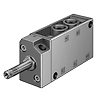Solenoid valve
-
Product is not available
Country Of Origin : India
Tiger Classic valve
Characteristics
At a glance
General information:
• Particularly sturdy poppet valve principle for all 3/2- and 5/2-way valves
• Pneumatically actuated or electrically with F solenoid coil
• With flow rate performance of up to 7500 l/min
• With internal or external pilot air
• Pipe connection thread in sizes G1/8, G1/4, G1/2 and G3/4
• Proven mounting using hollow bolt on PAL or PRS rail (without ATEX category)
• Optimised switching times thanks to patented U-ring and servo control
• Note: Valves for potentially explosive atmospheres (ATEX category) are not suitable for mounting on PAL manifold rails or PRS manifold blocks.
F solenoid coils:
• Voltage 12 to 230 V DC; 12 to 240 V AC (50 to 60 Hz)
• Power consumption 4.1 to 5.5 W DC; 3.85 to 9 VA AC
• Selected types in accordance with the ATEX directive for potentially explosive atmospheres
• Solenoid coil can be easily replaced at a later date
• Solenoid coil not included in the scope of delivery
Variants:
• VL/O-3-...: normally closed or normally open, depending on the choice of connections
• MFH-3-..., MOFH-3-...MFH-3-...Normally closed, MOFH-3-...Normally open; by turning the seal under the cover, these valves can be converted to the other valve versionsc.
• MFH-3-...-S: This valve type can be used within a range of 0 to 0.8 MPa and also as MOFH (through flow when not actuated) with a separate pilot line.
• MFH-5-...-S: The external pilot air connection means that these valves can also be used with low operating pressures.
Mounting method
The valves Tiger Classic can be mounted on manifold rails PAL with common supply port or on PRS manifold blocks with common supply port and common exhausts. The valves are attached to the rails and blocks using hollow bolts. The manifold rail and manifold block have 2 to 6 valve positions. Vacant positions on the PAL manifold rails can be sealed with cap nuts, and on the PRS blocks cover plates can be used. The individual valves can be supplied with separate pressure levels via hollow bolts with threaded connections.


